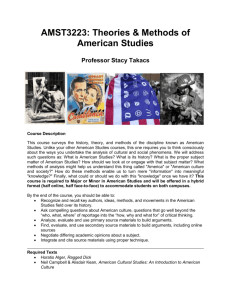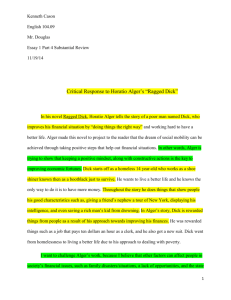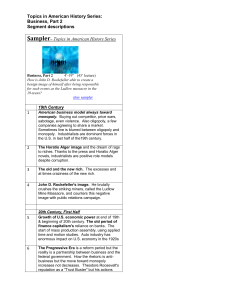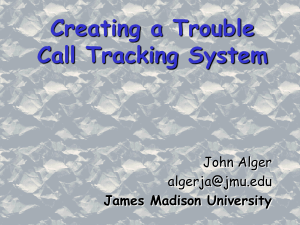– Unit 9, Chapter 25 (12 Ed.)
advertisement
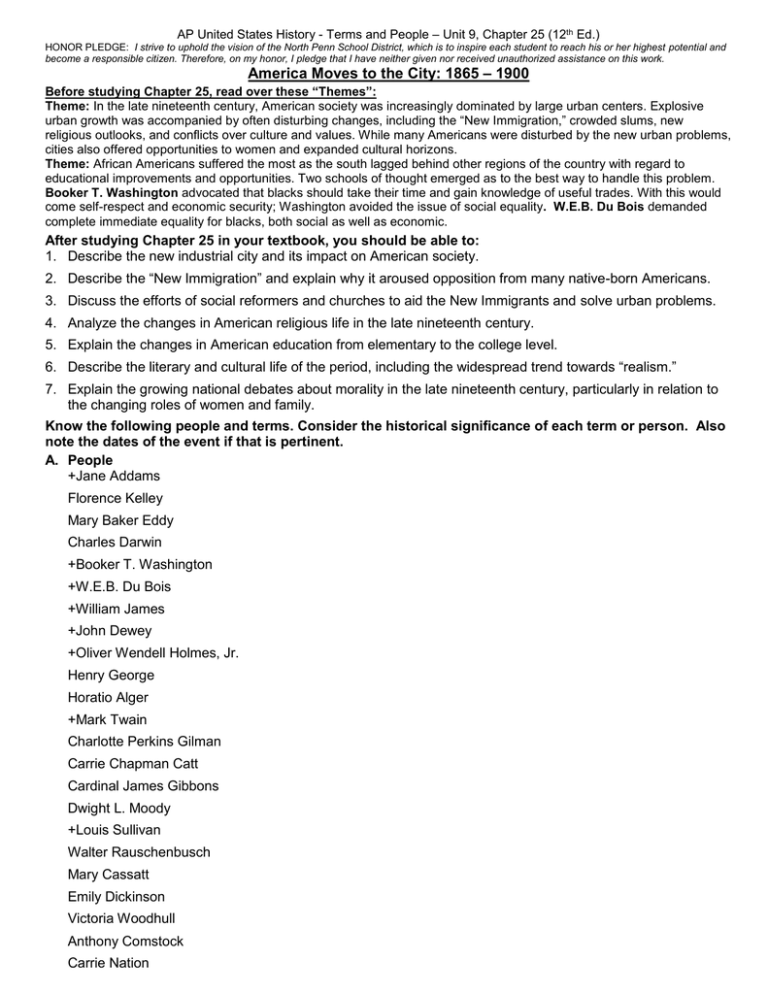
AP United States History - Terms and People – Unit 9, Chapter 25 (12th Ed.) HONOR PLEDGE: I strive to uphold the vision of the North Penn School District, which is to inspire each student to reach his or her highest potential and become a responsible citizen. Therefore, on my honor, I pledge that I have neither given nor received unauthorized assistance on this work. America Moves to the City: 1865 – 1900 Before studying Chapter 25, read over these “Themes”: Theme: In the late nineteenth century, American society was increasingly dominated by large urban centers. Explosive urban growth was accompanied by often disturbing changes, including the “New Immigration,” crowded slums, new religious outlooks, and conflicts over culture and values. While many Americans were disturbed by the new urban problems, cities also offered opportunities to women and expanded cultural horizons. Theme: African Americans suffered the most as the south lagged behind other regions of the country with regard to educational improvements and opportunities. Two schools of thought emerged as to the best way to handle this problem. Booker T. Washington advocated that blacks should take their time and gain knowledge of useful trades. With this would come self-respect and economic security; Washington avoided the issue of social equality. W.E.B. Du Bois demanded complete immediate equality for blacks, both social as well as economic. After studying Chapter 25 in your textbook, you should be able to: 1. Describe the new industrial city and its impact on American society. 2. Describe the “New Immigration” and explain why it aroused opposition from many native-born Americans. 3. Discuss the efforts of social reformers and churches to aid the New Immigrants and solve urban problems. 4. Analyze the changes in American religious life in the late nineteenth century. 5. Explain the changes in American education from elementary to the college level. 6. Describe the literary and cultural life of the period, including the widespread trend towards “realism.” 7. Explain the growing national debates about morality in the late nineteenth century, particularly in relation to the changing roles of women and family. Know the following people and terms. Consider the historical significance of each term or person. Also note the dates of the event if that is pertinent. A. People +Jane Addams Florence Kelley Mary Baker Eddy Charles Darwin +Booker T. Washington +W.E.B. Du Bois +William James +John Dewey +Oliver Wendell Holmes, Jr. Henry George Horatio Alger +Mark Twain Charlotte Perkins Gilman Carrie Chapman Catt Cardinal James Gibbons Dwight L. Moody +Louis Sullivan Walter Rauschenbusch Mary Cassatt Emily Dickinson Victoria Woodhull Anthony Comstock Carrie Nation AP United States History - Terms and People – Unit 9, Chapter 25 (12th Ed.) HONOR PLEDGE: I strive to uphold the vision of the North Penn School District, which is to inspire each student to reach his or her highest potential and become a responsible citizen. Therefore, on my honor, I pledge that I have neither given nor received unauthorized assistance on this work. B. Terms: megalopolis tenement settlement house despotism nativism evolution pragmatism Religious Modernists yellow journalism New Immigration Social Gospel Hull House American Protective Association Salvation Army Chautauqua movement *Morrill Land Grant Act of 1862 Comstock Act / Law Women’s Christian Temperance Union Eighteenth Amendment National American Woman Suffrage Association Horatio Alger stories (see pages 5 and 6) +=One of the 100 Most Influential Americans of All Time, as ranked by The Atlantic. Go to Webpage to see all 100. *=A 100 Milestone Document from the National Archive. Go to Webpage to link to these documents. C. Sample Essays: Using what you have previously learned and what you read in Chapter 25, you should be able to answer essays such as these: 1. What new opportunities did cities create for Americans? 2. How did the “New Immigration” differ from the “Old Immigration,” and how did Americans respond to it? D. Voices from the past: To those of my race who depend on bettering their condition in a foreign land or who underestimate the importance of cultivating friendly relations with the Southern white man, who is their next-door neighbor, I would say: “Cast down your bucket where you are. . . . The wisest among my race understand that the agitation of questions of social equality is the extremist of folly. . . . Booker T. Washington, “The Atlantic Compromise” (1895) Now is the accepted time, not tomorrow, not some more convenient season. It is today that our best work can be done and not some future day or future year. It is today that we fit ourselves for the greater usefulness of tomorrow. Today is the seed time, now are the hours of work, and tomorrow comes the harvest and the playtime. W.E.B. Du Bois America's future will be determined by the home and the school. The child becomes largely what he is taught; hence we must watch what we teach, and how we live. Jane Addams, American social reformer (1860-1935) AP United States History - Terms and People – Unit 9, Chapter 25 (12th Ed.) HONOR PLEDGE: I strive to uphold the vision of the North Penn School District, which is to inspire each student to reach his or her highest potential and become a responsible citizen. Therefore, on my honor, I pledge that I have neither given nor received unauthorized assistance on this work. E. Cities Grow: Source: U.S. Bureau of the Census http://www.census.gov/population/www/documentation/twps0027.html Population of top 10 Urban Places: 1790 Rank | Place | Population 1 New York city, NY ..................... 33,131 2 Philadelphia city, PA ................. 28,522 3 Boston town, MA ....................... 18,320 4 Charleston city, SC..................... 16,359 5 Baltimore town, MD...................... 13,503 6 Northern Liberties township, PA 9,913 7 Salem town, MA.......................... 7,921 8 Newport town, RI........................ 6,716 9 Providence town, RI ................... 6,380 10t Marblehead town, MA..................... 5,661 10t Southwark district, PA ................ 5,661 Population of top 10 Urban Places: 1800 Rank | Place | Population 1 New York city, NY ..................... 60,515 2 Philadelphia city, PA ................. 41,220 3 Baltimore city, MD...................... 26,514 4 Boston town, MA ....................... 24,937 5 Charleston city, SC..................... 18,824 6 Northern Liberties township, PA .. 10,718 7 Southwark district, PA ................ 9,621 8 Salem town, MA.......................... 9,457 9 Providence town, RI ................... 7,614 10 Norfolk borough, VA..................... 6,926 Population of the top 10 Urban Places: 1810 Rank | Place | Population 1 New York city, NY ..................... 96,373 2 Philadelphia city, PA ................. 53,722 3 Baltimore city, MD...................... 46,555 4 Boston town, MA ...................... 33,787 5 Charleston city, SC.................... 24,711 6 Northern Liberties district, PA . 19,874 7 New Orleans city, LA .............. 17,242 8 Southwark district, PA ............ 13,707 9 Salem town, MA....................... 12,613 10 Albany city, NY....................... 10,762 Population of top 10 Urban Places: 1820 Rank | Place | Population 1 New York city, NY ............... 123,706 2 Philadelphia city, PA ........ .. 63,802 3 Baltimore city, MD............ ..... 62,738 4 Boston town, MA .................. 43,298 5 New Orleans city, LA ............ 27,176 6 Charleston city, SC................ 24,780 7 Northern Liberties district, PA 19,678 8 Southwark district, PA ........... 14,713 9 Washington city, DC .............. 13,247 10 Salem town, MA..................... 12,731 Population of top 10 Urban Places: 1830 Rank | Place | Population 1 New York city, NY ....... 202,589 2 Baltimore city, MD........ 80,620 3 Philadelphia city, PA ... 80,462 4 Boston city, MA ......... 61,392 5 New Orleans city, LA ...... 46,082 6 Charleston city, SC....... 30,289 7 Northern Liberties district, PA 28,872 8 Cincinnati city, OH........ 24,831 9 Albany city, NY........... 24,209 10 Southwark district, PA ........... 20,581 Population of top 10 Urban Places: 1840 Rank | Place | Population 1 New York city, NY ............... 312,710 2 Baltimore city, MD................. 102,313 3 New Orleans city, LA .......... 102,193 4 Philadelphia city, PA ............ 93,665 5 Boston city, MA .................. 93,383 6 Cincinnati city, OH................ 46,338 7 Brooklyn city, NY ................ 36,233 8 Northern Liberties district, PA . 34,474 9 Albany city, NY.................... 33,721 10 Charleston city, SC................ 29,261 Population of top 10 Urban Places: 1850 Rank | Place | Population 1 New York city, NY .............. 515,547 2 Baltimore city, MD................ 169,054 3 Boston city, MA ...... ........... 136,881 4 Philadelphia city, PA ........... 121,376 5 New Orleans city, LA .......... 116,375 6 Cincinnati city, OH................ 115,435 7 Brooklyn city, NY ................ 96,838 8 St. Louis city, MO................. 77,860 9 Spring Garden district, PA .... 58,894 10 Albany city, NY.................... 50,763 Population of top 10 Urban Places: 1860 Rank | Place | Population 1 New York city, NY ............... 813,669 2 Philadelphia city, PA ........... 565,529 3 Brooklyn city, NY ................ 266,661 4 Baltimore city, MD................ 212,418 5 Boston city, MA *.................. 177,840 6 New Orleans city, LA .......... 168,675 7 Cincinnati city, OH................ 161,044 8 St. Louis city, MO................. 160,773 9 Chicago city, IL................... 112,172 10 Buffalo city, NY................... 81,129 AP United States History - Terms and People – Unit 9, Chapter 25 (12th Ed.) HONOR PLEDGE: I strive to uphold the vision of the North Penn School District, which is to inspire each student to reach his or her highest potential and become a responsible citizen. Therefore, on my honor, I pledge that I have neither given nor received unauthorized assistance on this work. Population of top 10 Urban Places: 1870 Rank | Place | Population 1 New York city, NY ............... 942,292 2 Philadelphia city, PA.............. 674,022 3 Brooklyn city, NY ................ 396,099 4 St. Louis city, MO............... .. 310,864 5 Chicago city, IL................... 298,977 6 Baltimore city, MD................. 267,354 7 Boston city, MA .................. 250,526 8 Cincinnati city, OH................ 216,239 9 New Orleans city, LA............... 191,418 10 San Francisco city, CA........... 149,473 Population of top 10 Urban Places: 1880 Rank | Place | Population 1 New York city, NY ............. 1,206,299 2 Philadelphia city, PA............. 847,170 3 Brooklyn city, NY ................ 566,663 4 Chicago city, IL................... 503,185 5 Boston city, MA .................. 362,839 6 St. Louis city, MO................. 350,518 7 Baltimore city, MD................. 332,313 8 Cincinnati city, OH................ 255,139 9 San Francisco city, CA........... 233,959 10 New Orleans city, LA............ 216,090 Population of top 10 Urban Places: 1890 Rank | Place | Population 1 New York city, NY ................ 1,515,301 2 Chicago city, IL................... 1,099,850 3 Philadelphia city, PA.............. 1,046,964 4 Brooklyn city, NY ................ 806,343 5 St. Louis city, MO................. 451,770 6 Boston city, MA.................... 448,477 7 Baltimore city, MD................. 434,439 8 San Francisco city, CA............. 298,997 9 Cincinnati city, OH................ 296,908 10 Cleveland city, OH................. 261,353 Population of top 10 Urban Places: 1900 Rank | Place | Population 1 New York city, NY ............. 3,437,202 2 Chicago city, IL................... 1,698,575 3 Philadelphia city, PA........... 1,293,697 4 St. Louis city, MO................. 575,238 5 Boston city, MA.................... 560,892 6 Baltimore city, MD................. 508,957 7 Cleveland city, OH................ 381,768 8 Buffalo city, NY................... 352,387 9 San Francisco city, CA......... 342,782 10 Cincinnati city, OH.............. 325,902 Population of top 10 Urban Places: 1910 Rank | Place | Population| 1 New York city, NY ...... 4,766,883 2 Chicago city, IL......... 2,185,283 3 Philadelphia city, PA.... 1,549,008 4 St. Louis city, MO....... 687,029 5 Boston city, MA.......... 670,585 6 Cleveland city, OH....... 560,663 7 Baltimore city, MD....... 558,485 8 Pittsburgh city, PA *.... 533,905 9 Detroit city, MI......... 465,766 10 Buffalo city, NY......... 423,715 Population of top 10 Urban Places: 1920 Rank | Place Population 1 New York city, NY ...... 5,620,048 2 Chicago city, IL......... 2,701,705 3 Philadelphia city, PA.... 1,823,779 4 Detroit city, MI......... 993,078 5 Cleveland city, OH....... 796,841 6 St. Louis city, MO....... 772,897 7 Boston city, MA.......... 748,060 8 Baltimore city, MD....... 733,826 9 Pittsburgh city, PA...... 588,343 10 Los Angeles city, CA..... 576,673 Population of top 10 Urban Places: 1930 Rank | Place |Population 1 New York city, NY ...... 6,930,446 2 Chicago city, IL......... 3,376,438 3 Philadelphia city, PA.... 1,950,961 4 Detroit city, MI......... 1,568,662 5 Los Angeles city, CA..... 1,238,048 6 Cleveland city, OH....... 900,429 7 St. Louis city, MO....... 821,960 8 Baltimore city, MD....... 804,874 9 Boston city, MA.......... 781,188 10 Pittsburgh city, PA...... 669,817 Population of top 10 Urban Places: 1940 Rank | Place Population 1 New York city, NY ...... 7,454,995 2 Chicago city, IL......... 3,396,808 3 Philadelphia city, PA.... 1,931,334 4 Detroit city, MI......... 1,623,452 5 Los Angeles city, CA.... 1,504,277 6 Cleveland city, OH...... . 878,336 7 Baltimore city, MD....... 859,100 8 St. Louis city, MO....... 816,048 9 Boston city, MA.......... 770,816 10 Pittsburgh city, PA...... 671,659 F. What were “Horatio Alger stories”? Read on to find out - - > AP United States History - Terms and People – Unit 9, Chapter 25 (12th Ed.) HONOR PLEDGE: I strive to uphold the vision of the North Penn School District, which is to inspire each student to reach his or her highest potential and become a responsible citizen. Therefore, on my honor, I pledge that I have neither given nor received unauthorized assistance on this work. The Real Horatio Alger by W. S. Ross "Horatio Alger hero" is a common phrase in America, referring to the person who achieves success by his own effort in the face of great obstacles. Over 100 books with such heroes were written by Horatio Alger (1834-1899), whose stories of boys overcoming poverty were widely read in the 19th century. Yet Alger's novels are virtually nowhere to be found today. This state of affairs regarding Alger motivates a number of questions: What were his novels really like? What is the essence of the Horatio Alger hero as portrayed in his novels? Why were they so famous in their time? And why did they lose popularity? It might be easy to assume that the demise of Alger's popularity is solely due to the change in our culture from the individualism of the 19th century to the anti-individualism of the 20th. This, however, is only part of the reason. A Typical Plot We can begin to understand his ideas by relating the story of his first and most famous novel - Ragged Dick (1867). Dick is a bootblack in turn-of-the-century New York City who is near starvation. He sleeps in the streets every night and wakes up hungry and penniless. He is an industrious shoeshiner, however, who earns just enough to eat after a couple of hours of work. As the story unfolds, it becomes clear that he is an amiable fellow with a good sense of humor, but that he wastes what little money he earns on going to nighttime entertainments - shows, gambling, etc., and in throwing parties for friends. Despite his flaws, he is portrayed as an honest boy, who would not cheat or steal from anyone - despite given frequent opportunity to do so. He overhears a wealthy businessman speaking to his nephew. The nephew has just arrived in the city for a visit, but his uncle must attend to business and cannot show him the sights. Dick offers to show the boy, Frank, around. The businessman accepts the offer, despite Dick's raggedness, because he senses Dick's honesty and familiarity with New York sights. As a requirement for entrusting his nephew to Dick, however, the businessman asks that Dick clean himself up and wear a suit of Frank's, so that he'll look respectable enough to show Frank around. Just being around Frank, and hearing Frank's many stories of famous men who were once poor but by thrift and hard work attained a fortune, Dick begins to think that he might have a possibility of another kind of life. His sense of future possibilities is enhanced by the self-respect his new garb and his unprecedented cleanliness instills in him. Dick, in his turn, protects Frank from some unscrupulous swindlers that lurk around the city streets. After Frank's visit is over, Dick's changed attitude results in pursuit of a better job than bootblacking. He develops a habit of saving rather than squandering. He fulfills his desire to learn to read and write by studying with another boy at nights, reaching the position where he can compose a letter to his friend Frank. He also finds accommodations in an inexpensive room so that he does not have to live on the street. By months of saving and hard work, he accumulates a comfortable nest egg of $100, a sum unheard of in his earlier spendthrift life. At the end of the story he is still having difficulty finding another type of work, but after saving the life of a businessman's son, and after the businessman hears of his efforts to improve himself, he is offered an office job at what for him is an enormous salary of $10 per week. This affords an unlimited potential for improving his lot in life. The Three Elements of an Alger Story This story contains the three elements of almost every Alger story. First, there is the desperate situation of a poor boy, who by difficult effort improves himself and succeeds. This is the heroic element that most people refer to and respond to when they admire an Alger story. It relies on a view of man as having free will and a self-made soul. In particular, observe that Dick changes from someone who lives short-range to someone who thinks about the future. He is able to discipline himself to prepare for the future across time, even though his progress is incremental. Both in his acquisition of a modest sum of money and in his acquisition of knowledge, we see him act consistently to obtain a distant goal. This is why Alger is often said to promote "middle-class values." The members of the middle class improve themselves gradually, across time. They do not take enormous risks, do not seek "quick kills," but by discipline and consistent hard work they improve their situation - financially and intellectually. Observe, however, that the virtue of consistent hard work based on conceptualizing the future in the present is generally applicable to all men, ones of extraordinary ability who take larger risks as well as to members of the middle class who possess more limited competence. Consider also that Dick does all this of his own conscious choice. Although he is stimulated to improve by contact with Frank, his choice is his own and he must sustain it even when Frank is not present. The contact with Frank, however, introduces the second element of an Alger story: chance. The novel Ragged Dick is not plot-driven; it is not based solely on the fundamental premise or goal of the main protagonist. Rather the story is driven by a chance encounter with a wealthy businessman and his nephew, Frank (and later by a chance encounter with a wealthy businessman and his drowning son). Would Dick have achieved success without this encounter? Would he have changed? The story doesn't make it clear. It is precisely the injection of chance events in a story that blurs the author's message of self-reliant effort as the source of success. Dick's character is a mixture of elements, some good and others not. The two aspects of character that Alger seems to think are decisive in overcoming Dick's faults are honesty and productiveness. He describes Dick at the beginning of the story as follows: "He was above doing anything mean or dishonorable. He would not steal, or cheat, or impose upon younger boys, but was frank and straight-forward, manly and self-reliant. His nature was a noble one, and had saved him AP United States History - Terms and People – Unit 9, Chapter 25 (12th Ed.) HONOR PLEDGE: I strive to uphold the vision of the North Penn School District, which is to inspire each student to reach his or her highest potential and become a responsible citizen. Therefore, on my honor, I pledge that I have neither given nor received unauthorized assistance on this work. from all mean faults. I hope my young readers will like him as I do, without being blind to his faults [smoking, playing pranks, wasting his money]." Alger later refers to Dick's "energy, ambition, and natural sharpness," and both aspects of his character are dramatized throughout the book, with Dick's less responsible attributes slowly changed as the story proceeds. These two - honesty and productiveness - are a combination of character traits that could be used by an author with the proper approach to explain success without any chance events. Alger, however, seems unable to do it. Chance encounters of this kind appear in every novel of his I've read. The two elements of an Alger novel discussed so far - heroic effort and chance - are what people refer to when they characterize an Alger novel as depicting "luck and pluck" (Luck and Pluck is in fact the title of one of his novels.) The third element of an Alger novel comes from the nature of the chance encounters - they almost always consist of the beneficence of a wealthy man toward a poor boy. In Ragged Dick it is Frank's uncle and the father of the drowning boy. In The Errand Boy it is the President of a railroad. In Struggling Upward it is a wealthy relative. Often, the poor boy does something to deserve the gift, but Alger makes it appear that this is not always a trade but a moral duty on the part of the wealthy man. One of Frank's stories to Dick is of a wealthy British businessman who had been given his start by being adopted by a wealthy man. There was no trade involved - it was a pure gift. And of course, both of Dick's chance encounters are of the same sort. While touring New York, Dick says to Frank: "If everybody was like you and your uncle...there would be some chance for poor people. If I was rich I'd try to help 'em along." So the three elements of the Alger novel, as exhibited in Ragged Dick and his other books, are "luck," "pluck," and ... altruism. This is a deadly and self-contradictory mixture. It was discussed above how the introduction of "luck" undermines heroism. In Alger, this undermining is implicit. Alger could have left his altruism implicit if he had merely introduced the gifts of wealthy strangers as story elements, without explicit philosophizing. Even implicit altruism would have undercut the heroism: Logically, if poor boys need the help of wealthier benefactors to succeed (whether strangers or long-lost relatives), it means they are not capable on their own of succeeding. Alger, however, goes far beyond mere implication in endorsing altruism and undermining heroism. In the following exchange between Dick and Frank, Dick expresses a different attitude than one would expect to hear from the self-reliant streetwise boy he originally appears to be: " 'I'd like it if some rich man would adopt me, and give me plenty to eat and drink and wear, without my havin' to look so sharp after it. Then agin' when I've seen boys with good homes, and fathers, and mothers, I've thought I'd like to have somebody to care for me.' "Dick's tone changed as he said this, from his usual levity, and there was a touch of sadness in it. Frank, blessed with a good home and indulgent parents, could not help pitying the friendless boy who had found life such up-hill work. " 'Don't say you have no one to care for you, Dick,' he said, lightly laying his hand on Dick's shoulder. 'I will care for you.' “‘Will you?' “‘If you will let me.' “‘I wish you would,' said Dick, earnestly.’I'd like to feel that I have one friend who cares for me.' " A more maudlin and self-pitying exchange of dialog can hardly be found in literature, let alone 19th century literature. And it comes from the mouth of the "hero" invented by the writer of books about boys who "gain success by leading exemplary lives and struggling valiantly against poverty and adversity" (Columbia Concise Encyclopedia). Instead of Dick's taking the responsibility for raising himself up, and viewing poverty as a condition to be born until he can do something about it, he wants to be taken care of. And instead of admiration on the part of his benefactor, the benefactor feels pity. This is the true implication and underlying philosophy of altruism - that man is a helpless creature who needs to be taken care of and pitied rather than left alone and admired for his achievements. The introduction of altruism thus blows heroism to pieces. From Altruism...to Anti-Capitalism Alger's altruism leads him, as one might predict, to explicit attacks on capitalism and capitalists. As identified by the biographer Gary Scharnhorst in his The Lost Life of Horatio Alger, Jr., such attacks permeate his books: From Rupert's Ambition - "Rupert did not envy his father's old partner." I would rather be poor and honest,' he reflected, 'than live in a fine house, surrounded by luxury, gained by grinding the faces of the poor.'" In Number 91, he criticizes the idea of rebates. He personally crusaded against the railroad rebates of the late 1870's. Alger railed against stock speculation, specifically mentioning or alluding to Jay Gould as evil in Store Boy and in Luke Walton. In Paul the Peddler and Luke Walton he endorsed the "dog-eat-dog" attack on capitalism, saying there were too many competitors in the market and that this dropped prices too much, i.e. capitalism was subject to what moderns call "market failure." In many books he stated the Marxist critique that capitalism only pays subsistence wages and that the laborer is worth more, and if he isn't paid more he is being exploited. He endorsed unionization in Ben the Luggage Boy and in Slow and Sure. In Luke Walton he endorsed usury laws. In Tom Tracy he criticized the profit motive. Little wonder that with some selectivity, both in which novels were published and even in which chapters from those novels were included in later editions, Alger was enthusiastically promoted by the Progressives. Writers of the political left, like Theodore Dreiser, Jack London, and Upton Sinclair, all claim to have been influenced by reading Alger. Alger himself admired Teddy Roosevelt, though he died before Roosevelt became president and famous as a "trustbuster."
